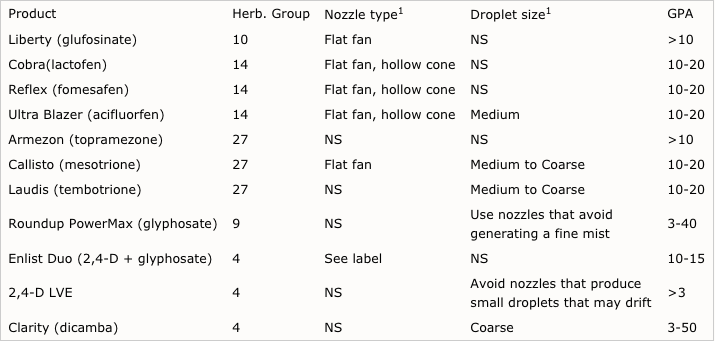By Bob Hartzler, Agronomist; H. Mark Hanna, Extension Ag Engineer
The article, “Spray Volume Critical for Post-Emergence Herbicides,” discusses the affects of nozzle type and size on spray coverage, and prompted a question from a farmer regarding nozzle selection.
In recent years there have been many advances in nozzle design. The primary improvement has been development of nozzles that minimize the formation of driftable droplets (less than 200 micron) while still producing a droplet spectrum that provides the level of coverage required for consistent, post-emergence weed control.
A standardized system of classifying droplet size has been adopted, and this information is provided by nozzle manufacturers. Droplet size classification is determined not only by the nozzle type, but also by nozzle size and operating pressure. For example, an XR TeeJet 11004 operated at 40 PSI is rated at Medium, whereas at 50 PSI it’s rated at Fine. When choosing nozzles, be sure to consider the full range of operating pressures they will be operated under when using rate controllers that adjust operating pressure based on sprayer speed.

The Enlist Duo label lists specific combinations of nozzles and PSI ranges that may be used with this product. This is a new method of regulating the risk of drift associated with herbicide applications adopted by EPA. Only nozzles that have been evaluated for the range of droplet sizes produced when applying Enlist Duo can be recommended on the label. Additional nozzles are likely to be added to the label as new information is developed.
Spray volume also affects herbicide efficacy. Post-emergence applications are often made when weeds are “shielded” from direct contact with the spray by the crop canopy. Spray volume can have more of an impact on the ability to achieve good coverage of targets within a canopy than the nozzle type. Most herbicide labels recommend increasing spray volume when making applications to large weeds or in situations with dense canopies.
As herbicide programs are adjusted to account for herbicide resistance, the need to alter application methods is often overlooked. Sprayers must be properly equipped and calibrated in order to optimize herbicide performance and minimize the potential for off-target movement.
The use of trade names in this article is for clarity by the reader. Due to the large number of generic products on the market, Iowa State University Extension is not able to include all products. Inclusion of a trade name does not imply endorsement of that particular brand of herbicide and exclusion does not imply non-approval.





